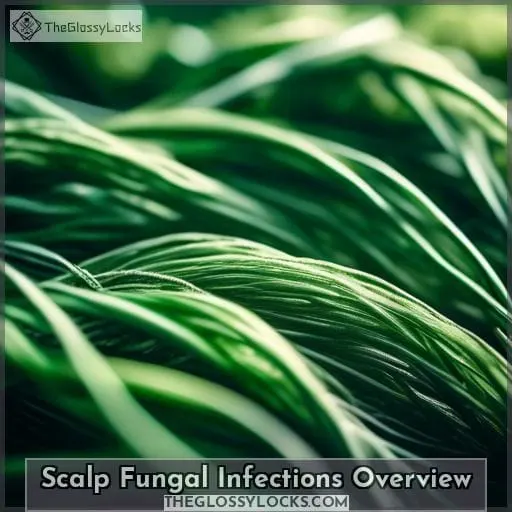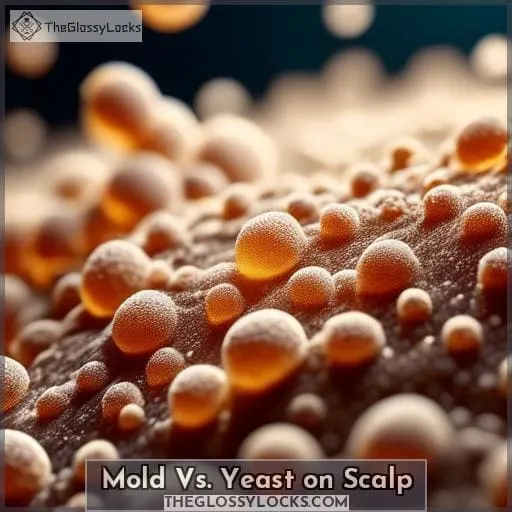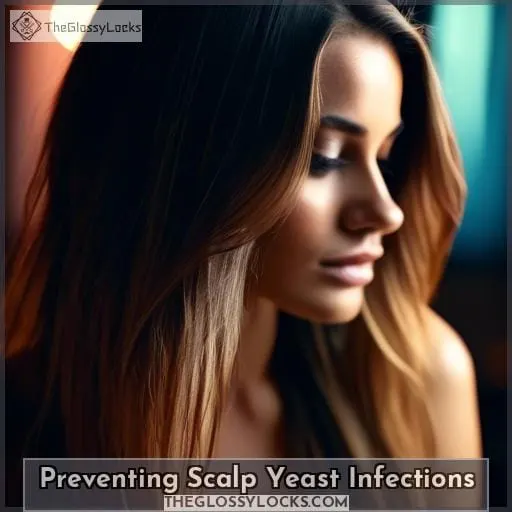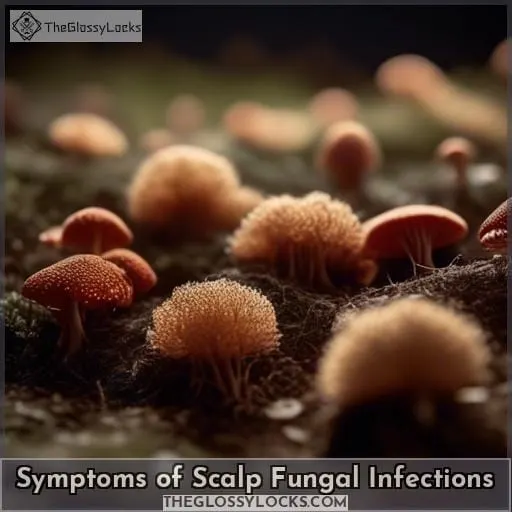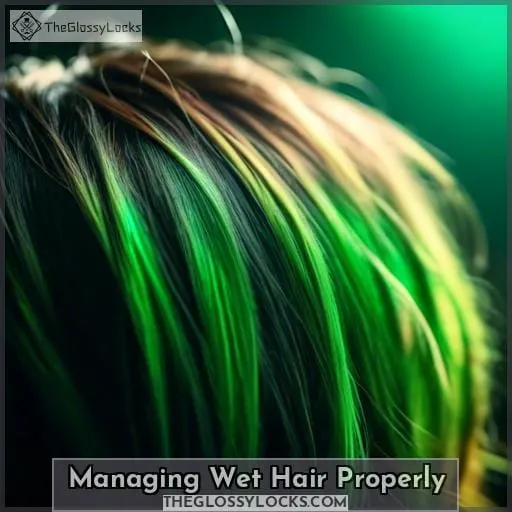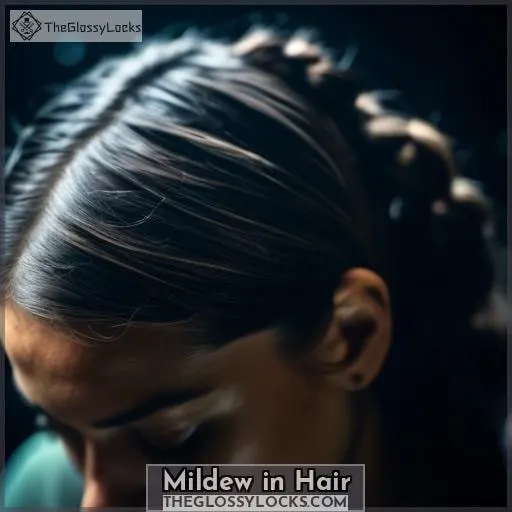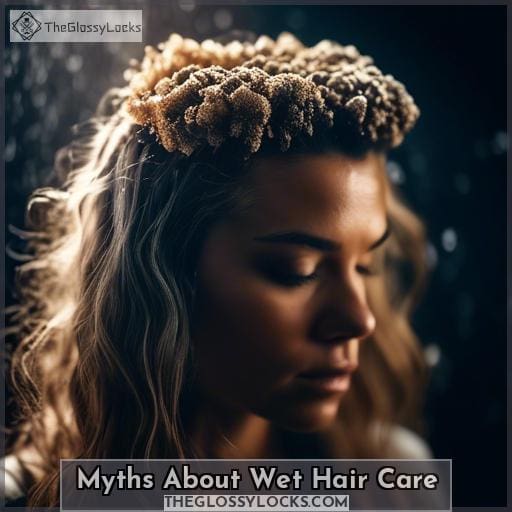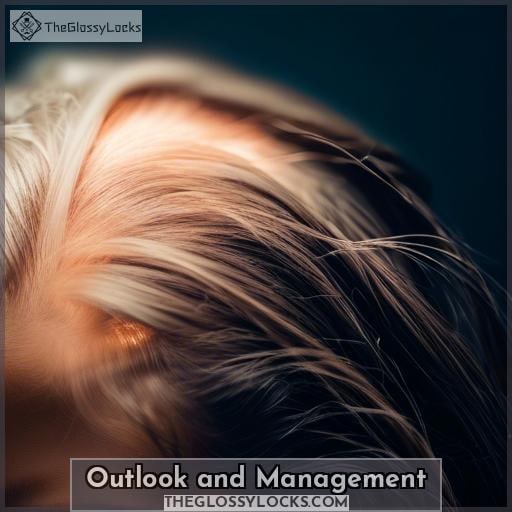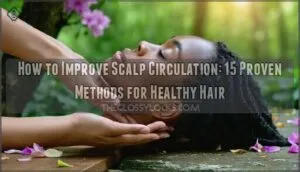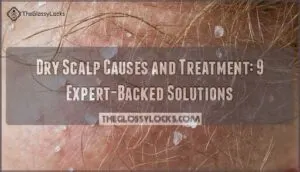This site is supported by our readers. We may earn a commission, at no cost to you, if you purchase through links.
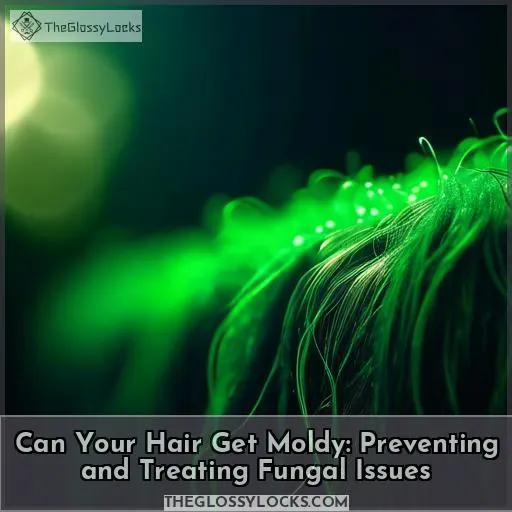 Wondering if your hair can get moldy? It’s a concern that’s not only valid but also important for your overall scalp health.
Wondering if your hair can get moldy? It’s a concern that’s not only valid but also important for your overall scalp health.
While mold, a type of fungus thriving in moist environments, doesn’t typically grow on human hair, other fungal issues like yeast infections can impact your scalp, leading to discomfort and hair problems.
Understanding the difference between mold and yeast, along with recognizing the symptoms and causes of scalp fungal infections, is crucial. This guide dives into preventing, identifying, and treating these conditions, ensuring your hair remains healthy and free from unwanted fungal guests.
Let’s explore how to keep your scalp in top condition and debunk some common myths about wet hair care along the way.
Yes, your hair can get moldy, especially if it remains damp for extended periods without proper airflow to the scalp. Mold and mildew growth in hair is uncommon but can occur under moist conditions.
Table Of Contents
- Key Takeaways
- Scalp Fungal Infections Overview
- Mold Vs. Yeast on Scalp
- Preventing Scalp Yeast Infections
- Symptoms of Scalp Fungal Infections
- Treatment Options
- Managing Wet Hair Properly
- Mildew in Hair
- Myths About Wet Hair Care
- Outlook and Management
- Frequently Asked Questions (FAQs)
- Can hair dye or coloring treatments contribute to mold growth on the scalp?
- How does the pH level of the scalp affect the risk of developing mold or yeast infections?
- Are there any specific hair types or textures that are more susceptible to mold growth?
- Can dietary changes help prevent mold and yeast infections on the scalp?
- Is it possible for mold to grow on synthetic hair extensions or wigs?
- Conclusion
Key Takeaways
- Mold growth on hair is uncommon but can occur in moist conditions, and it is typically caused by yeast infections rather than mold itself.
- Scalp fungal infections, including those caused by yeast or ringworm, can lead to symptoms such as dandruff, hair loss, and itchy rashes, and they thrive in warm, moist environments.
- Mold rarely grows on human hair, but exposure to mold can lead to allergies, while yeast infections on the scalp can cause dandruff and hair loss.
- To prevent scalp yeast infections and mold growth, it is important to keep the scalp clean and dry, dry hair thoroughly after washing, avoid going to bed with wet hair, and practice good hygiene.
Scalp Fungal Infections Overview
When it comes to your scalp’s health, understanding the causes and risk factors of fungal infections is crucial. Fungal infections, including those caused by yeast, can lead to uncomfortable symptoms such as dandruff, hair loss, and itchy rashes.
These conditions thrive in warm, moist environments, making the scalp a common site for such infections. By keeping your scalp clean and dry, you can significantly reduce your risk of developing these issues.
Causes and Risk Factors
When it comes to the nitty-gritty of scalp fungal infections, you’re dealing with a sneaky bunch. These unwelcome guests, including the likes of ringworm causes, seborrheic dermatitis triggers, and piedra transmission, can turn your scalp into their personal playground if given the chance.
Picture this: fungal overgrowth throwing a party on your head, with mold, yeast, and fungus as the main guests causing everything from dandruff to hair loss.
Now, you might wonder, How did I get on the guest list? Well, these fungi aren’t picky about their hosts. They love warm, moist environments, and if your scalp fits the bill, consider yourself a prime target.
Whether it’s from sharing hats, a sweaty gym session, or even a cuddle with your furry friend suspected of having ringworm, these critters find their way in.
But here’s where it gets interesting: not all fungi are bad news. Some, like the yeast that gives us bread and beer, are actually quite useful. However, when it comes to your scalp, it’s a different story. Conditions like cutaneous mucormycotic diagnosis require swift action to prevent serious complications.
So, if you notice any signs of fungal freeloading, it’s time to show them the door with proper treatment and care. Remember, an ounce of prevention is worth a pound of cure, especially when dealing with these uninvited guests.
Common Types and Symptoms
When it comes to your scalp, a few uninvited guests can make themselves at home, causing more than just a bad hair day.
- Dandruff: This flaky interloper is often due to a yeast-like fungus, leaving you with an itchy scalp and a snowfall on your shoulders.
- Black Piedra: Imagine finding tiny black pebbles clinging to your hair strands—this fungal infection makes that a reality.
- White Piedra: Not to be outdone, white piedra shows up as lighter nodules, giving your hair an unwanted accessory.
- Scalp Ringworm: This one’s a party crasher, causing scaly, inflamed patches and sometimes leaving bald patches in its wake.
Mold Vs. Yeast on Scalp
You might be surprised to learn that while mold is commonly associated with damp environments, it doesn’t actually grow on human hair.
However, yeast, another type of fungus, can thrive on your scalp, potentially leading to conditions like hair loss or dandruff.
Understanding the difference between these fungi and how they affect your scalp is crucial for effective prevention and treatment.
Misconceptions About Mold
Let’s clear the air about mold and yeast on your scalp, shall we? It’s easy to get tangled up in myths, but understanding the facts can keep your headspace happy and healthy.
| Aspect | Mold | Yeast |
|---|---|---|
| Growth on Scalp | Rarely, if ever. Mold prefers your leftovers, not your locks. | Yes, especially if you’re giving it a cozy, damp environment. |
| Common Issues | Mold exposure can lead to allergies but isn’t a scalp’s fan. | Dandruff and hair loss, thanks to party crashers like Malassezia. |
| Cosmetic Effects | None directly on hair, but let’s not invite it to try. | Hello, flakiness and goodbye, shine. |
| Treatment | Keep dry to avoid. Mold in hair is more myth than reality. | Medicated shampoos and antifungal creams to the rescue. |
Yeast Infections and Their Impact
Continuing from the previous discussion on mold, let’s shift gears to its pesky cousin, yeast. Unlike mold, yeast is quite the opportunist on your scalp, leading to some hair-raising issues like dandruff and hair loss.
Picture this: a yeast overgrowth throws a party on your head, and suddenly you’re itching like you’ve got an internal DJ scratching a turntable up there.
Yeast infections, like a bad houseguest, can overstay their welcome, causing symptoms that are anything but a laughing matter. If you’re dealing with a flaky situation up top, it’s not just about hair dandruff; it could be a sign of a fungal fiesta, and it’s time to clean house.
Good scalp hygiene is your bouncer, keeping these unwanted guests in check. So, if you’re scratching your head wondering about those itchy red patches, remember, it’s not just about keeping your hair mold-free; it’s about showing yeast the door before it triggers hair loss or turns your scalp into a flake festival.
Preventing Scalp Yeast Infections
Maintaining a dry and clean scalp is crucial in preventing yeast infections that can lead to uncomfortable symptoms and hair issues.
It’s important to practice good hygiene, such as drying your hair thoroughly after washing and avoiding going to bed with wet hair.
Additionally, minimizing contact with pets that may carry ringworm can help prevent the spread of fungal infections.
Importance of Dry Hair
Keeping your hair dry is crucial for maintaining scalp health and preventing fungal issues like yeast infections.
Wet hair can create a breeding ground for yeast, leading to problems such as hair loss, dandruff, and even hair mold. To dodge these hairy situations, it’s best to avoid hitting the hay with damp locks.
After a sweat session, make sure to shower and thoroughly dry your hair to keep those pesky yeast at bay. And remember, your scalp is the soil for hair growth; keep it healthy to avoid hair dryness and the dreaded split ends.
Prevention is key, so treat your mane with care, and you’ll keep both hair loss and fungal parties off your head.
Hygiene and Pet Contact
Keeping your scalp healthy isn’t just about drying your hair; it’s also about your daily habits. Think of your immune system as a bouncer at the club of your scalp, keeping out unwanted guests like yeast.
Swap out hair accessories often, as they can harbor unseen critters. And remember, sharing isn’t always caring—especially with hair styling tools that might spread hair lice or fungi.
Tackle hair tangles and knots gently to avoid breakage and resist the temptation to borrow hair wigs, which might bring more than just a new look.
Symptoms of Scalp Fungal Infections
When it comes to scalp fungal infections, recognizing the symptoms early on is crucial for effective treatment and preventing further spread.
If you notice unusual changes such as itchy, flaky patches, bald spots, or red and inflamed areas on your scalp, it’s time to seek medical advice.
These signs could indicate a range of fungal infections, including ringworm, seborrheic dermatitis, or even more serious conditions like cutaneous mucormycosis, each requiring a specific approach to treatment.
Identifying Different Infections
Identifying different infections on your scalp can feel like solving a mystery without the clues. But don’t worry, you’re not alone in this hairy situation. When it comes to fungal issues, it’s a jungle up there, with various fungal strains playing hide and seek.
If your hair’s becoming a bit moldy, it’s likely not the work of a classic mold but rather a sign of a fungal fiesta.
For starters, if you spot black or white growths clinging to your hair like tiny, unwelcome ornaments, you might be dealing with piedra. Think of black piedra as the dark knight of the fungal world, lurking in tropical climates, while white piedra prefers a lighter touch.
Seborrheic dermatitis, on the other hand, is like that uninvited guest causing a flaky mess, leading to dandruff and red, itchy skin. And let’s not forget about cutaneous mucormycotic, the big bad wolf of fungal infections, causing more drama than a soap opera with its blisters and potentially life-threatening antics.
When to Seek Medical Help
As you navigate the itchy and flaky seas of scalp troubles, remember that not all who wander are lost—but some do need a map to the doctor’s office.
If your scalp’s sending out SOS signals like persistent dandruff, bald patches, or painful blisters, it’s time to seek professional guidance. Don’t let stubborn scalp skirmishes escalate; expert consultation can turn the tide.
So, when your home remedies and over-the-counter potions fail to smooth the stormy waves of hair frizz or soothe the fiery redness, chart a course to medical attention.
Treatment Options
When it comes to treating fungal issues in your hair, you’re not alone in seeking solutions.
Medications, shampoos, and even home remedies can be effective in managing and eliminating these problems.
It’s essential to choose the right treatment to ensure your scalp and hair health is restored and maintained.
Medications and Shampoos
Continuing from the pesky symptoms of scalp fungal infections, let’s dive into the arsenal you’ve got to fight back. You’re not alone in this—it’s time to talk about your knights in shining armor: medicated shampoos and antifungal medications.
These topical treatments are your first line of defense, ready to charge into battle against the fungal hordes. Think of medicated shampoos as your trusty steed, galloping through your hair to deliver a potent dose of antifungal goodness right where it’s needed.
And when the going gets tough, antifungal medications are your cavalry, coming to the rescue to help clear the infection from within.
But don’t forget about the home remedies and natural solutions that can bolster your defenses. They’re like the local villagers joining the fray with pitchforks and torches—simple, but surprisingly effective.
So, if you’re wondering, Can your hair get moldy? rest assured, with the right treatment, you can keep your scalp as fortress-strong and free from fungal invaders.
Home Remedies and Care
When it comes to home remedies and care for your scalp, you’re in for a treat—literally.
- Whip up a DIY mildew spray with tea tree oil and water to tackle that pesky fungus.
- Embrace the power of apple cider vinegar for a scalp that’s as clean as a whistle.
- For those with curly hair mildew, a dab of coconut oil can work wonders.
- Keep your scalp as dry as a bone to prevent any uninvited fungal guests.
Managing Wet Hair Properly
When managing wet hair properly, it’s crucial to adopt effective drying techniques and select the right products to prevent fungal issues like mildew or mold.
Damp hair can create an ideal environment for fungal growth if not handled correctly. By ensuring your hair is thoroughly dried and using products designed to protect and nourish your scalp and hair, you can minimize the risk of developing these conditions.
Drying Techniques
After exploring the best ways to treat scalp fungal infections, let’s dive into the crucial step of drying your hair properly. You know the drill: damp hair is a playground for pesky fungi. So, let’s talk turkey about drying techniques that’ll keep your scalp in shipshape.
When it comes to drying your locks, you’ve got options. Towel drying is your first port of call; it’s like mopping up a spill before it gets out of hand. But remember, it’s not a race—be gentle to avoid turning your hair into a frizzy mess.
If you’re in a pinch, blow drying can be a lifesaver, but keep that heat on a leash! Think of it as toasting bread—you want it golden, not burnt. Air drying is the old faithful, just let nature do its thing. And for those of you who like to live on the edge with heat styling, don’t forget to shield your tresses with a heat protectant—think of it as your hair’s knight in shining armor.
Here’s a quick cheat sheet to keep these tips at your fingertips:
| Drying Technique | Key Points |
|---|---|
| Towel Drying | Be gentle, pat don’t rub |
| Blow Drying | Use moderate heat, keep it moving |
| Air Drying | Frizz-minimizing, natural method |
| Brush Drying | Detangle and smooth as you dry |
| Heat Styling | Protect before you perfect |
Product Selection
When it comes to managing wet hair properly, product selection is crucial for maintaining the perfect moisture balance and promoting healthy hair growth.
After you’ve gently towel-dried your hair, it’s time to choose the right products that won’t only protect your hair but also enhance its natural beauty. Opt for hydrating and protective products that cater to your hair’s specific needs.
Whether you’re aiming to add volume, define curls, or simply keep your hair looking shiny and healthy, there’s a plethora of options available. For instance, lightweight leave-in conditioners or detangling sprays can work wonders on damp hair, making it easier to comb through and reducing the risk of breakage.
If you’re planning to use heat styling tools, don’t forget to apply a heat protectant spray to shield your hair from damage. Remember, the key to luscious locks lies in finding the right balance between protein and moisture.
Products rich in natural oils and ingredients like aloe vera can help lock in moisture, while protein-based products will strengthen your hair. By selecting the right products, you’re not only taking a step towards healthier hair but also ensuring that your hair remains vibrant and full of life.
Mildew in Hair
Mildew in your hair is a real concern, especially if you often go to bed with wet hair or live in a humid environment.
This condition is caused by the trapping of moisture in your hair, which can lead to the growth of yeast and other fungi on your scalp.
To prevent and treat this issue, it’s crucial to ensure your hair is thoroughly dried after washing and to use specific cleansing methods to remove any existing mildew.
Causes and Prevention
Mildew in your hair is more than just a bad hair day waiting to happen; it’s a sign that your hair hygiene and scalp health need a bit of TLC. Think of your scalp as the soil in which your hair grows. Just like plants need healthy soil to thrive, your hair needs a healthy scalp to grow strong and shiny.
Mildew occurs when wet hair is left to stew in its own moisture, creating a breeding ground for fungus. This is especially true for styles that trap moisture, like buns or locs, or if you’re someone who sweats a lot.
Preventing mildew is all about keeping your scalp dry and airy. After washing, make sure to thoroughly dry your hair, using heat if necessary for thicker locks. If you’re a gym bunny, consider a quick scalp cleanse post-workout. And for those with braids, locs, or extensions, a spritz of Sea Breeze or a natural scalp cleanser like apple cider vinegar can work wonders in keeping your scalp fresh and free from fungal foes.
Remember, a clean and dry scalp is your first defense against the dreaded hair mildew.
Removal Methods
To tackle mildew in your hair, you’ll want to embrace a few key strategies for mildew prevention and removal.
-
DIY Mildew Removal Spray: Mix 2 tablespoons of tea tree oil with 2 cups of water in a spray bottle. Spritz it on your hair and scalp, leave it for 20-30 minutes, then shampoo out. Tea tree oil is a natural dandruff control agent and promotes scalp hygiene.
-
Clarifying Shampoos: Use a clarifying or medicated shampoo to wash away mildew. Remember, a clean scalp is a happy scalp, and keeping it free from buildup is crucial for preventing those unwanted fungal guests.
-
Proper Drying: Always dry your hair thoroughly. Damp environments are a playground for mildew, so after washing, ensure your hair is completely dry before styling or hitting the pillow.
Myths About Wet Hair Care
You might think that skipping the blow-dryer and going to bed with wet hair is a safe choice for your locks, but this common practice can actually invite fungal issues like mold growth on your scalp.
It’s crucial to handle wet hair with care, as it’s more vulnerable to damage and breakage. To maintain a healthy scalp and prevent fungal problems, always ensure your hair is thoroughly dry before hitting the pillow.
Debunking Common Beliefs
Continuing from the previous discussion on mildew in hair, let’s bust some myths about wet hair care. You might think that a quick bun with damp locks is harmless, but it’s a shortcut to frizz city and potentially worse.
| Common Misconceptions | The Real Deal |
|---|---|
| Going to bed with wet hair is harmless. | It can lead to scalp issues like mildew. |
| Brushing wet hair is fine with the right tool. | Wet hair is vulnerable, so be gentle to avoid damage. |
| Handling wet hair doesn’t require care. | Incorrect handling can cause breakage and loss. |
Correct Practices
In debunking common myths about wet hair care, it’s crucial to embrace correct practices for the sake of your scalp health and overall hair vitality.
First off, hitting the hay with damp locks isn’t just a recipe for a bad hair day; it’s an open invitation for fungal friends like mildew to party on your scalp. Instead, ensure your hair is thoroughly dry before you dream, using gentle drying methods that don’t wage war on your strands.
When it comes to detangling, treat wet hair like a delicate fabric; opt for a wide-tooth comb to gently ease out knots without causing breakage. Incorporating the right products into your hair care routine can make all the difference.
Look for leave-in conditioners and protective sprays that shield your hair from the elements, including the heat from styling tools.
Speaking of heat, always use a heat protectant before styling and keep that blow dryer or straightener moving to avoid frying your hair. Remember, your scalp is the soil from which your hair grows; nurturing it with proper care and product recommendations will ensure your hair remains healthy, strong, and free from fungal foes.
Outlook and Management
When it comes to managing and preventing fungal issues on your scalp, it’s crucial to understand that consistent care is key.
Fungal infections, like those caused by yeast or mold, can lead to uncomfortable and sometimes severe conditions if left untreated. However, with the right approach to treatment and prevention, most people can maintain a healthy scalp and minimize the risk of these infections reoccurring.
Chronic Conditions
Busting myths about wet hair care was just the tip of the iceberg. Now, let’s dive into the deep end with chronic scalp conditions. These aren’t your run-of-the-mill bad hair days; they’re the long-term guests that nobody invited but refuse to leave.
- Scalp conditions like seborrheic dermatitis can be a real party pooper, turning your scalp into a flaky, itchy mess. But don’t fret; with the right care, you can keep the flakes at bay.
- Chronic diseases such as psoriasis might make you feel like your scalp’s playing a never-ending game of red light, green light. The key? Patience and persistence with treatment.
- Hair loss isn’t just about finding strands in your brush. It’s a sign that your scalp’s crying out for help. Listen to it, and you might just save your mane from a disappearing act.
- Dry scalp might seem like no biggie, but it’s like the Sahara Desert up there—thirsty for moisture. Quench it with the right products, and you’ll be waving goodbye to itchiness.
Importance of Consistent Care
Maintaining your scalp hygiene isn’t just about avoiding the ick factor; it’s your ticket to a lush, healthy mane. Think of your scalp as the soil in which your hair’s roots thrive. Without consistent care, you’re inviting unwelcome guests like dandruff or, worse, hair loss.
| Aspect | Why It Matters | Quick Tip |
|---|---|---|
| Scalp Hygiene | Prevents fungal infections | Wash regularly, choose products wisely |
| Hair Dryness | Keeps the scalp environment healthy | Don’t skip the conditioner |
| Scalp Health | Directly impacts hair growth | Gentle massages boost circulation |
| Product Importance | Right products = Happy scalp | Look for nourishing ingredients |
| Hair Loss Prevention | A healthy scalp supports strong hair | Avoid tight hairstyles |
Frequently Asked Questions (FAQs)
Can hair dye or coloring treatments contribute to mold growth on the scalp?
Hair dye or coloring treatments can create a moist environment conducive to yeast growth on your scalp.
If not properly rinsed, these treatments may contribute to the development of such conditions.
How does the pH level of the scalp affect the risk of developing mold or yeast infections?
An optimal scalp pH, slightly acidic around 5, is your shield against the fungal underworld.
Veer too alkaline, and you’re rolling out the red carpet for yeast and mold parties.
Keep it balanced, and you’ll fend off those unwelcome guests.
Are there any specific hair types or textures that are more susceptible to mold growth?
Curly, coily, locked, and wavy hair types are more prone to mold growth, especially when styled in buns, ponytails, or updos.
This susceptibility is due to trapped moisture.
Can dietary changes help prevent mold and yeast infections on the scalp?
Wondering if tweaking your diet could fend off those pesky scalp issues? Absolutely!
Reducing sugar and starch intake can help prevent yeast infections on the scalp.
Plus, munching on foods like yogurt, Brazil nuts, and avocados can boost scalp health and keep those fungal foes at bay.
Is it possible for mold to grow on synthetic hair extensions or wigs?
Yes, mold can grow on synthetic hair extensions or wigs, especially if they’re not allowed to dry properly or if they’re kept in damp conditions.
Synthetic materials, while not natural, can still harbor moisture and create an environment conducive to mold and fungus growth. This is particularly true if the synthetic hair isn’t cleaned regularly or if it’s exposed to humid environments for extended periods.
Ensuring synthetic hair is thoroughly dried and stored in dry conditions can help prevent mold growth.
Conclusion
Just when you thought you knew everything about keeping your hair and scalp healthy, the reality of moldy hair creeps in, challenging common perceptions and care routines.
Yes, your hair can indeed become a haven for mold if left damp and neglected, turning what seems like a simple issue into a complex problem requiring immediate attention.
This guide has navigated through the murky waters of scalp fungal infections, distinguishing between mold and yeast, and shedding light on prevention, symptoms, and treatment options.
Armed with this knowledge, you’re now equipped to maintain a healthy scalp, debunk myths about wet hair care, and ensure your hair remains vibrant and mold-free.

